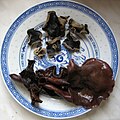Scientific names Commonly used names Image Traditional Chinese Simplified Chinese Pinyin Translation Notes, other Chinese names Cyclocybe aegerita poplar mushroom, velvet pioppino 茶樹菇 茶树菇 cháshùgū tea tree mushroom Auricularia heimuer wood ear 黑木耳 黑木耳 hēimù'ěr black wood ear Auricularia cornea cloud ear fungus 毛木耳 毛木耳 máomù'ĕr hairy wood ear Similar to wood ears, but coarser. Generally used in soups. Pleurotus giganteus 豬肚菇 猪肚菇 zhūdǔgū pig stomach mushroom Coprinus comatus shaggy ink cap 雞腿菇 鸡腿菇 jītuǐgū chicken leg mushroom Dacryopinax spathularia sweet osmanthus ear 桂花耳 桂花耳 guìhuā'ěr osmanthus ear Used in Buddha's delight . Flammulina filiformis enoki, enokitake 金(針)菇 金(针)菇 jīn(zhēn)gū gold (needle) mushroom Cultivated variety shown, wild differs in appearance. Ganoderma lingzhi reishi mushroom 靈芝 灵芝 língzhī supernatural mushroom Very bitter but believed to be medicinally highly potent. Often made into a tea or broth with Chinese wolfberries . Gloeostereum incarnatum 榆耳 榆耳 yú'ěr elm ear Used in Buddha's delight . Hericium erinaceus lion's mane mushroom, bearded tooth mushroom 猴頭菇 猴头菇 hóutóugū monkey head mushroom Hericium ramosum Hypsizygus tessulatus white beech mushroom 蟹味菇 蟹味菇 xièwèigū crab flavor mushroom Lentinula edodes shiitake 香菇 香菇 xiānggū fragrant mushroom Termitomyces spp. termite mushroom 雞㙡 雞肉絲菇 鸡𭎂 [ a] / 鸡肉丝菇 jīzōng jīròusīgū chicken meat strip mushroom (name #2) Phallus indusiatus bamboo mushroom 竹蓀 竹荪 zhúsūn Considered an aphrodisiac . Used in chicken soups. Pleurotus eryngii king oyster mushroom 杏鮑菇 杏鲍菇 xìngbàogū apricot abalone mushroom Pleurotus ostreatus oyster mushroom 蠔菇 蚝菇 háogū oyster mushroom Also known as 秀珍菇 (pinyin : xiùzhēngū Russula virescens green brittlegill 青頭菌 青头菌 qīngtóujùn green-headed mushroom Thelephora ganbajun dried beef mushroom 乾巴菌 干巴菌 gānbājùn ganba mushroom A highly prized mushroom, taxonomically described in 1987. It takes its name from 干巴牛肉 (pinyin : gānbāniúròu Yunnanese specialty of dried beef. Naematelia sinensis 金耳 金耳 jīn'ěr golden ear Used in Buddha's delight . Also known as 黃耳 黄耳 pinyin : huáng'ěr ; lit. ' yellow ear ' ) Tremella fuciformis silver ear fungus, snow fungus 銀耳 银耳 yín'ěr silver ear Also known as 雪耳(pinyin : xuě'ěr ; lit. ' snow ear ' ) and 白木耳 (pinyin : báimù'ěr ; lit. ' white wood ear ' ) Tricholoma matsutake matsutake 松茸 松茸 sōngróng pine bud Expensive delicacy, especially highly prized in Japan. Volvariella volvacea paddy straw mushroom 草菇 草菇 cǎogū straw mushroom 


















